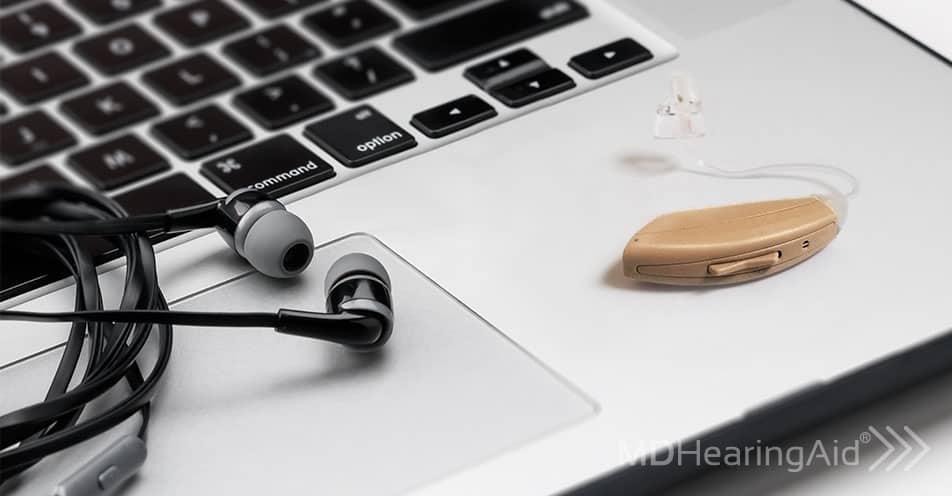When you first receive the hearing aid you purchased online, figuring out what to do next can be a bit confusing. The batteries are often small and the controls can be overwhelming at first glance. Once you put the hearing aid in your ear, there are sounds you probably haven’t heard clearly or at all in quite some time, and your brain needs to adjust to interpreting these sounds again. To help with the adjustment, here are some tips for getting the most out of your new hearing aid.
Step 1: Familiarize yourself with the controls
Even if you have used a hearing aid before, the controls on your new hearing aid may take some time to fully understand. All MDHearing devices have a volume control and a program control. If you want the get the most out of your hearing aid, you need to know how to adjust both of these settings to optimize your hearing. Depending on the hearing aid model, the volume control will either be a dial or a push-button. The program control is usually a separate button, but on the LifeEar CORE, it shares the button with the volume control. Review your hearing aid manual for specific instructions on how to change both the volume (level of amplification) and the program setting (which frequencies are amplified).
Take time to learn how to remove the tubing and put it back on, as this is required for regular maintenance of the device. If the sounds suddenly stops on your hearing aid, more often than not it’s just a small clog in the tubing that can easily be cleared by removing the tubing and using the black cleaning wire. More information can be found in your user manual.
Step 2: Set the volume to your hearing
It can be tricky figuring out how to adjust hearing aid volume. When you first put the battery in your hearing aid, we suggest sitting in a quiet room at home with one other person and setting the volume so your companion’s conversational voice is at a comfortable level. This volume level will allow you to get used to the new sound quality and the everyday background sounds that you may have been missing for some time.
Most likely, there will be a number of noises that seem unusually loud at first – such as your own voice, the hum of the air conditioning, even the beeping of your microwave or oven – but this is due to the fact that you have not heard these sounds properly in some time. This is completely normal. As your brain gets reacquainted with these sounds, they will become less distracting.
Step 3: Find the right program for you
All MDHearing devices arrive at your door programmed with multiple settings designed to help the majority of people with hearing loss. Your user manual will describe what situation these settings are best in, but, since everyone’s hearing is different, you may find one of the programs on your hearing aid works best for you in most situations. It’s perfectly okay to find a single setting that sounds good to you and stick with it. When starting out with a new hearing aid, the best way to discover what works for your hearing situation is to try all the programs on your device in different noise environments during your daily routine and compare how they sound to you.
Step 4: Be patient
No hearing aid, regardless of price, can restore the normal hearing of youth. When you talk on the phone, your conversation partner’s voice will sound a bit different, as even with the best phones there is a subtle difference when the human voice is transmitted over a phone line or via cellular signal. The same goes for the sounds you hear with your hearing aids. Your original hearing ability won’t be restored 100% and some sounds you hear through your hearing aids may be a little different than you remember. However, your brain can adapt to these differences, and you can adjust to hearing with hearing aids. You just need to give it time.
Enlisting the help of your family and friends can be really helpful during the hearing aid adjustment process. First, they can help by giving you an opportunity to practice speaking in groups in a comfortable atmosphere. This will help your brain relearn the associations between sounds, words, and nonverbal body language. This is best to do with friends and family because their voices are already familiar to your brain, and thus the easiest to identify and interpret. They also can help you adjust by setting the television at a comfortable volume, giving you the chance to listen and adapt to these new volumes.
Step 5: Enjoy hearing again
Don’t forget to have fun, enjoy the outdoors, hear the birds singing in the morning, listen to crickets chirping at night, gossip with your neighbors on the porch, catch up with a friend at the cafe. The world is full of sounds you might not have been able to enjoy in a long time. As you rediscover your hearing, we suggest starting a hearing journal to keep track of any noises that surprise you, like the newspaper rustling or your feet on the ground. If a ticking clock seems loud today, write it down and make a note of the last time you remember hearing a clock tick.
Remember that patience is key. Be patient with yourself and your hearing aids, and within a few months (or even weeks), you will be enjoying all the sounds of life again. To read more about hearing aids, hearing loss, maintenance tips, etc., check out our blog. And if you ever have questions, don’t hesitate to contact us!
